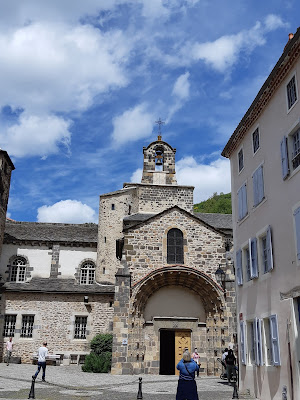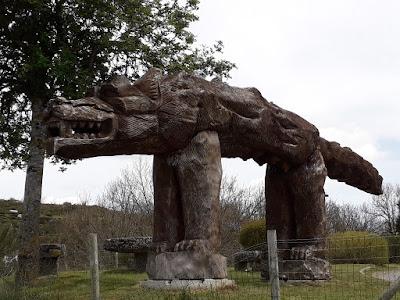
It started with a map attached to a French travel magazine about the Auvergne region. Blesle was highlighted as a medieval town with a history that designated it as one of the "Plus Beaux Villages de France" (Most Beautiful Villages of France). Two Benedictine abbeys for women were founded there, and the town was only 90 minutes northwest of Le Puy. We had to go there!
Getting there, of course, would mean going through the mountains on two-lane highways, some of which were so rural, they didn't even have a dividing line for two-way traffic let alone enough space for two cars to pass. However, as usual, a little persistence and patience brought us to a place that not only whetted our interest but inspired our delight of discovery.
We brought a picnic lunch with us but couldn't find a park or place to land for our hearty repast of ham sandwiches, potato chips, apples, and chocolate in this busy little burg of 635 people (2018). We followed the main road through town, which sometimes became so narrow, I thought it was an alley! So we pressed onward and after 10 minutes of forest and mountains, we came upon a river, a bench, and a place to park the car at St. Etienne-sur-Blesle.
There was really not much there, there--at least in the present tense. The old Benedictine abbey for women had been abolished in 1353 and was a crumbling heap of stone. An empty factory built in 1747 lay dormant just waiting for someone to pick up the pieces and begin again. Some beautiful but isolated houses found solace in the nothingness of the mountains. A western-style log cabin with a "saloon" sign and an old, rusted-out car nestled itself at the foot of one mountain that sported some intriguing rock formations.
 Our picnic site provided us with a bench to sit on, a babbling stream behind us, mountains in front of us, an abandoned convent above us, and a beautiful stone church down the road. What seemed like the middle of nowhere had provided us with an interesting feast of ocular delight.
Our picnic site provided us with a bench to sit on, a babbling stream behind us, mountains in front of us, an abandoned convent above us, and a beautiful stone church down the road. What seemed like the middle of nowhere had provided us with an interesting feast of ocular delight.

The Voireuze River flows through St. Etienne-sur-Blesle and Blesle before it connects to the Alagnon River (54 miles long), the Allier River (7 miles long) and finally the Loire River (625 miles long), which empties into the Atlantic Ocean. Fishing is a popular sport here with good stocks of salmon, brown trout, and other river fish. Hiking and geocaching are also popular in this area.
The basalt rock mountains were formed by the Cézallier volcano. Rivers then carved out the area's valleys and plateaus.
 This church dates from the 19th century, but it originated as a small chapel built between 1735-1738. In 2006, the town restored the interior of the church thanks to a resident's generous donation.
This church dates from the 19th century, but it originated as a small chapel built between 1735-1738. In 2006, the town restored the interior of the church thanks to a resident's generous donation.

Posing with a bit of geologic history.
 This structure was a Benedictine abbey for women founded in the 9th century, but closed in 1353. The site was abandoned in the 18th century.
This structure was a Benedictine abbey for women founded in the 9th century, but closed in 1353. The site was abandoned in the 18th century.  Another view of the abbey's buildings with more questions arising about how these buildings were built on this hill high above the road and in such a remote place. It's logical to see why the abbey was built in this place: isolation from the mainstream of life, subsistence, and communal living are the hallmarks of cloister whose members seek solitude for a life of prayer and meditation.
Another view of the abbey's buildings with more questions arising about how these buildings were built on this hill high above the road and in such a remote place. It's logical to see why the abbey was built in this place: isolation from the mainstream of life, subsistence, and communal living are the hallmarks of cloister whose members seek solitude for a life of prayer and meditation.  This amazing mid-18th century factory foreshadows the age of industrialization in 19th Europe. Now in the 21st century, it looks as though it's begging for new life. That may take some imagination since this building is quite isolated from civilization, 10 minutes away from Blesle, far from any farm fields, and on a river too small and too shallow for barges.
This amazing mid-18th century factory foreshadows the age of industrialization in 19th Europe. Now in the 21st century, it looks as though it's begging for new life. That may take some imagination since this building is quite isolated from civilization, 10 minutes away from Blesle, far from any farm fields, and on a river too small and too shallow for barges. Someone must have money to live in this stunning three-story house with surrounding gardens. It is located across the street from the factory and was probably the owner's home--and a successful owner was he! The isolation of this house led me to wonder who its current occupants are and what they do. Fortunately, cars close the gap of long-distance travel, and wifi makes communications easy.
Blesle
Blesle began as the seat of another Benedictine abbey for women. It developed during the Middle Ages, and an 11th century castle testifies to its importance for the nobility of this region. The town is graced a maze of alleys, old half-timbered houses, houses with stone walls, arcades, and hand-carved doors, which all witness to its glorious past. Today, the area attracts hikers and trout fishers in a beautiful natural setting of mountains, rivers, valleys, and forests.




Holy Spirit Gate, the entrance to the northside of the village, was built in the 16th century and destroyed in 1822.


 Called "the Tower of 20 Angles", this structure was built in 1748 by
Thomas d'Espinchal, the last lord of Massia. It became a prison from
1793-1847 under the Barons of Mercœur.
Called "the Tower of 20 Angles", this structure was built in 1748 by
Thomas d'Espinchal, the last lord of Massia. It became a prison from
1793-1847 under the Barons of Mercœur. Saint-Pierre Abbey in Blesle

 A woman's monastery was built here in the 9th century. Ermengarde, countess of the Auvergne area and mother of William the Pius (875-918), was a great promoter and benefactor of the Benedictine Rule (est. 516). She chose Blesle to found a monastery and went to Rome to successfully place it under apostolic authority. Later on, the Pope established it as a Cluny Benedictine abbey under the name of Saint Pierre. The abbey was richly endowed, and it grew rapidly to include 15 abbeys under its wing by 1185.
A woman's monastery was built here in the 9th century. Ermengarde, countess of the Auvergne area and mother of William the Pius (875-918), was a great promoter and benefactor of the Benedictine Rule (est. 516). She chose Blesle to found a monastery and went to Rome to successfully place it under apostolic authority. Later on, the Pope established it as a Cluny Benedictine abbey under the name of Saint Pierre. The abbey was richly endowed, and it grew rapidly to include 15 abbeys under its wing by 1185.
In the 15th century, the nuns abandoned communal life in the abbey in favor of living independently in homes constructed around the church. In 1625, the monastery re-established its association with Cluny which continued until the French Revolution (1789-99) when it and most churches and religious orders were forcibly disbanded.
The Saint-Martin
Bell (on top of the tower) is the only vestige of the Saint-Martin Church (14th century). This
church had provided sacramental
functions but was demolished during the French Revolution. A cemetery that once surrounded
the church was later extended.
The sanctuary of Saint Pierre Abbey is an astonishingly impressive sight upon walking into the church from a side door. The color and majesty of the "cul-de-four" or half-sphere dome, was painted in the 19th century.
In the center of the dome is a medallion painting of Christ giving St. Peter the keys to the Kingdom.
There is nothing left of the orignal Romanesque church. Instead, the building has been reconstructed, modified, and refashioned with additional elements over the centuries. The church began to take its present shape beginning in the 12th century and includes many 16th, 17th, and 19th century additions.
The church has many interesting architectural elements. For example, the capitals outside the building depict plants, animals, dragons, acrobats, and modillions (ornaments under the cornice of a building). These figures are actually alchemical symbols used to express the qualities of healing and spiritual transformation.
Alchemy came to Europe in the 8th century and to France in the 12th century, courtesy of the Arabs of Spain. Alchemists were sometimes regarded as
saints, magi, or sorcerers who had the power of healing. They were also
the masters in charge of the
"companion builders," those who erected the great cathedrals. Alchemy
sought to
bring together all forms of knowledge including numerology, mathematics,
astronomy, and astrology. For more on medieval alchemical symbols, see my blog post: Alchemical Symbols in Medieval Architecture.



Consoles with heads. The designers of this church never missed an opportunity to decorate the various architectural forms!
Photos by Raymond Faure
Early
medieval representations of Christ focused on his divinity and triumph
over death. Later medieval art focused on his humanity to show that he
suffered in the same way that human beings suffer. The implication of
this change is that God (and Mary) are sympathetic to human suffering, according to Dr. Nancy Ross, art historian at Dixie State College of Utah.

"All of these Pietàs were devotional images and were intended as a focal point for contemplation and prayer" says Dr. Ross. "Even though the statues are horrific, the intent was to show that God and Mary, divine figures, were sympathetic to human suffering, and to the pain, and loss experienced by medieval viewers."
Photos by Raymond Faure 
I'm continually amazed at all the interesting places the Auvergne region offers. After all, when people think of France, they usually think of Paris, Nice, Marseille, Lyon, which are all important, no doubt about it. However, rural south-central France offers hidden gems often overlooked in favor of the big cities--as well as tourists' limitations on time for exploring this beautiful and historical country.
If the coronavirus lock-downs had an upside, taking time to discover these villages was it for us! Although each medieval village is similar in theme and structure, each has its own unique history and geography. And even more astounding: people still live in these villages even though the buildings and streets are hundreds of years old.
Sources
https://www.allovoyages.fr/mag/villages-haute-loire/
Dr. Nancy Ross, art historian at Dixie State College of Utah


































